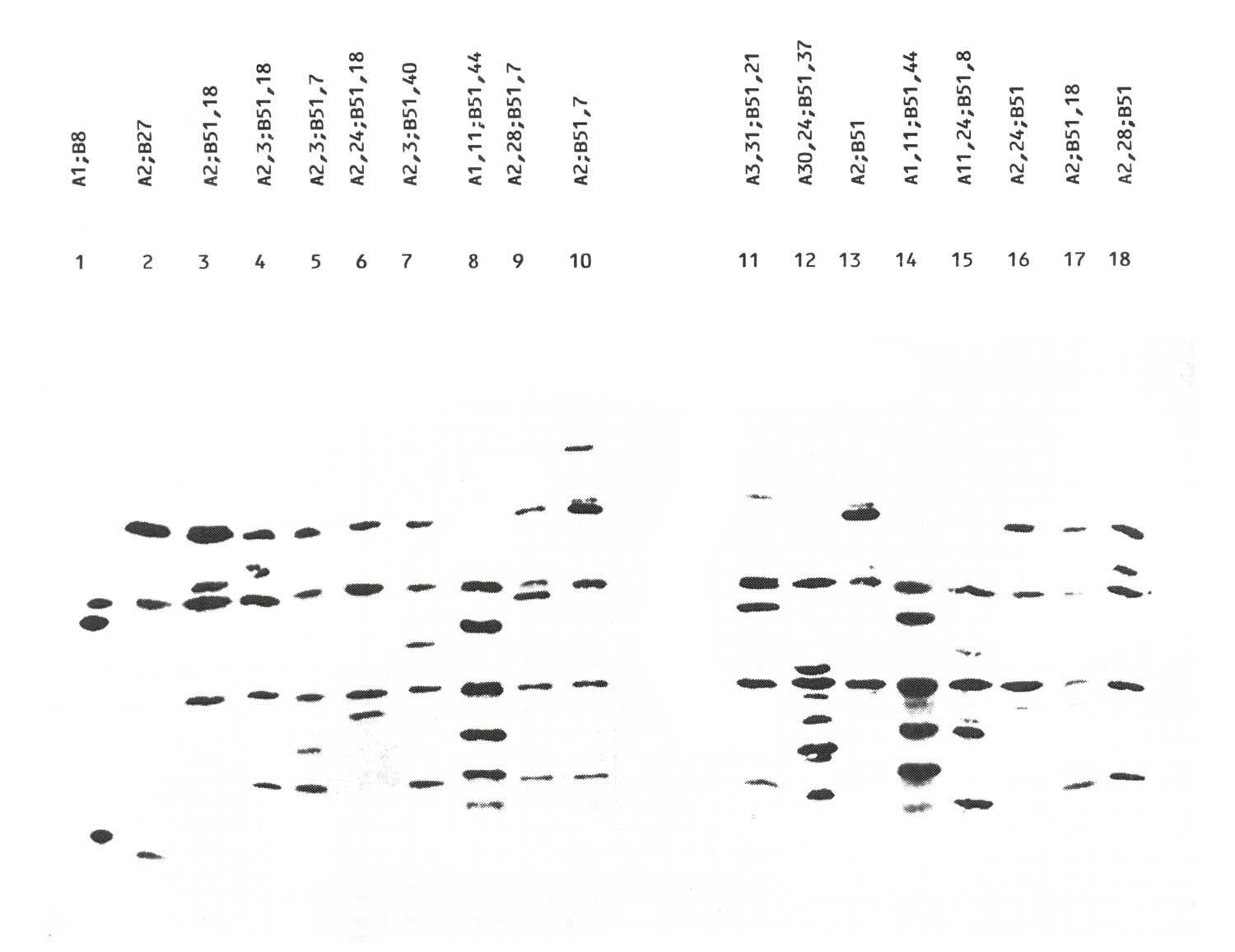DISEASE MARKERS,
VOL. 6, 275-277 (1988)
Failure to find a B51 Ief variant associated with Behcet's disease
O. R. Baricordi (1), l. Melchiorri (1), A. Balboni (1), S. Perrone (2), P. Pivetti-Pezzi (3), and A. Sensi (1)
(1) Istituto di Genetica Medico, Università di Ferrara, Italy; (2) Istituto di Clinica Oculistica, Università di Padova, Italy; (3) Istituto di Oftalmologia, Università La Sapienza di Roma, Italy
SUMMARY
HLA B51 antigen from 8 Italian Behcet's disease (BD) patients and 8 healthy controls were analyzed by isoelectric focusing (IEF). No differences were found in the migration patterns.
Key Words
Bechet's B51
INTRODUCTION
HLA B51 serological specificity is a well-defined immunogenetic marker for the ocular form of Behcet's Disease (Ohno et al., 1978; Yazici et al., 1980; Okuyama et al., 1984; Baricordi et al., 1986), a multifocal vasculitis mainly involving eye, genitals, and oral mucosa. Although, to our knowledge, B51 molecular heterogeneity has not been described (Clark et al., 1987), a low frequency variant with a stronger association to BD cannot be ruled out.
In the search for a more strongly BD associated B51 subtype we compared, by IEF analysis, HLA antigens obtained from 8 BD patients and 8 healthy subjects.
Eight B51 positive Italian BD patients, all with prominent ocular involvement, and 8 unrelated B51 positive healthy donors provided cells either for Epstein-Barr Virus (EBV) transformation or PHA stimulation.
HLA antigens metabolically labelled with 35S methionine were obtained by immunoprecipitation with the anti-HLA Class I monoclonal antibody W6/32 (Parham et al., 1979) from these cells. Immunoprecipitations were performed as reported by Neefjes et al., (1986a).
Composition of the IEF gel was as follows: 4·5 per cent polyacrilamide (30: 1·6 monoacrylamide/bisacrylamide) 9M urea, 10 per cent v/v NP40, 2 per cent amopholyte 3·5-10, 1·5 per cent ampholyte 5·0-7·0, 1·5 per cent ampholyte 6-0-8·0 LKB, Bromma, Sweden. IEF was conducted under the electrical conditions suggested by Nefjees et al. (1986a).
Two homozygous LCLs typed A1; B8 and A2; B27 were also included as suitable IEF markers (lanes 1 and 2 in Figure 1). The results are showed in Figure 1; band identification,assignedon the basis of the work ofNefjees et al. (1986b), is displayed in Figure 2.

Figure 1. IEF migration patterns of HLA Class I antigens from healthy subjects and BO patients. Lanes 1-2 homozygous LCLs used as IEF markers; lanes 3-10 healthy subjects; lane 11-18 BO patients. HLA Class I typing is showed on the top of each lane

Figure 2. Schematic diagram and bands identification of the autoradiogram shown in Figure 1. The dotted lines indicate unidentified products
It is obvious that B51 molecules obtained from healthy subjects and BD patients share a common isoelectric point. The data thus exclude a B51 IEF subtype strongly associated with Behcet's disease.
Although IEF cannot exclude B51 variants with identical isoelectric points, the failure to find a B51 IEF subtype more strongly associated with BO suggests that other immunogenetic markers (i.e. HLA class II antigens, immunoglobulin allotypes etc) should be further analysed in the attempt to define the genetic background of this multifactorial disease.
ACKNOWLEDGEMENTS
This work was supported by CNR 'Progetto Finalizzato Ingegneria Genetica e Basi Molecolari delle Malattie Ereditarie' 87 00 846.51.
REFERENCES
-
Baricordi, O.R., Sensi, A., Pivetti-Pezzi, P., Perrone, S., Balboni, A., Catarinelli, G., Filippi, F., Melchiorri, L., Moncada, A., Mattiuz, P.L. (1986). Behcet's disease associated with HLA B51 and DRw52 antigens in Italians. Hum. Immunol., 17, 297-301.
-
Clark, B.D., Park, M.S., Tonai, R., Terasaki, P.I. (1987). Serologic and biochemical analysis of HLA Bl5 and B5 complexes. Hum. Immunol., 20, 47-57.
-
Neefjes, J.J., Breur-Vriesendorp, B.S., Van Seventer, G.A., Ivanyi, P., Ploegh, H.L. (1986a). An improved biochemical method for the analysis of HLA class I antigens. Definition of new HLA class I subtypes. Hum. Immunol., 16, 169-181.
-
Neefjes, J.J., Doxiadis, F., Stam, N.Y., Beckers, C.Y., Ploegh, H.L. (1986b). Analysis of HLA class I of man and other species by one dimensional IEF and immunoblotting. Immunogenetics, 23, 164-171.
-
Ohno, S., Anasuma, T., Sugiura, S., Wakisaka, A., Aizawa, M.- (1978). HLA Bw51 and Behcet's disease. J.A.M.A., 240, 529
-
Okuyama, T., Kunikane, H., Kasahara, M., Ohno, S., Aizawa, M., Conighi, C., Perrone, S., Mattiuz, P.L. (1984). Behcet's disease. In: Albert, E.D., Baur, M.P., Mayr, W.R., (Eds). Histocompatibility Testing 1984, Berlin: Springer-Verlag, pp. 397-402.
-
Parham, P., Barnasatable, C.J., Bodmer, F.W. (1979). Use of a monoclonal antibody (W6/ 32) in structural studies of HLA-A, B, C antigens. J. Immunol., 123, 324-349.
-
Yazici, H., Chamberlain, M.A., Schreuder, I., Damaro, J., Huftuoglu, M. (1980). HLA antigens in Behcet's disease. A reappraisal by a comparative study of Turkish and British patients. Ann. Rheum. Dis., 39, 344-348.

